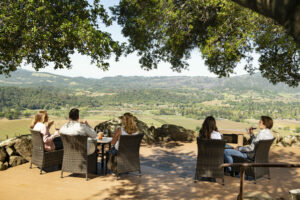
Sip fine wine under the redwoods or enjoy a sunset food pairing at one of these exquisite outdoor winery patios in Sonoma County this summer.
The post 6 Favorite Winery Patios in Sonoma County appeared first on Sonoma Magazine.
]]>
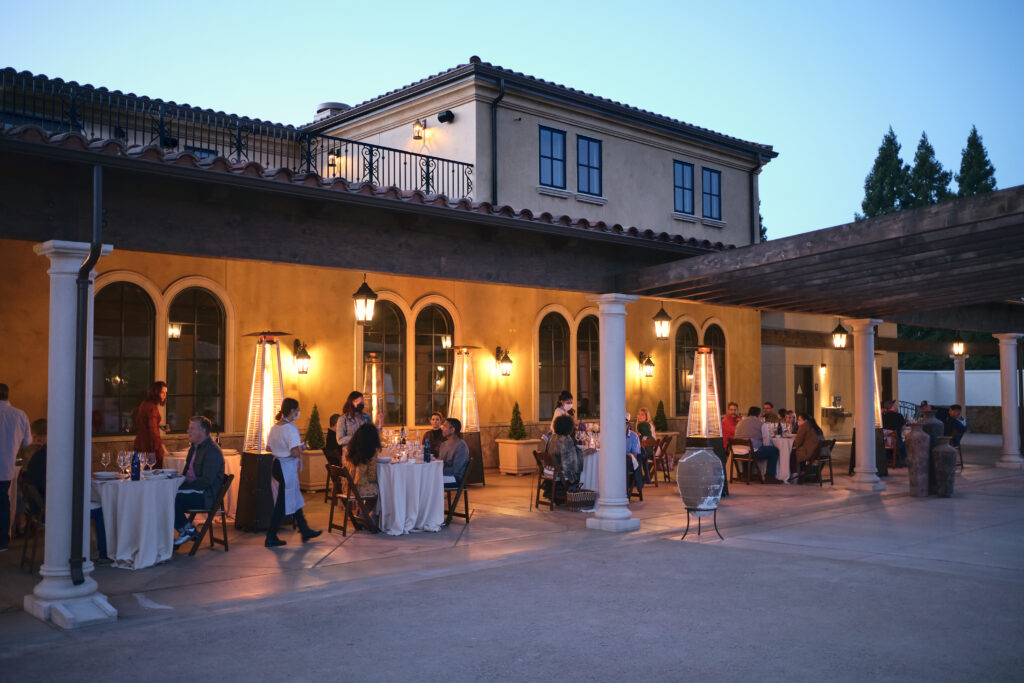
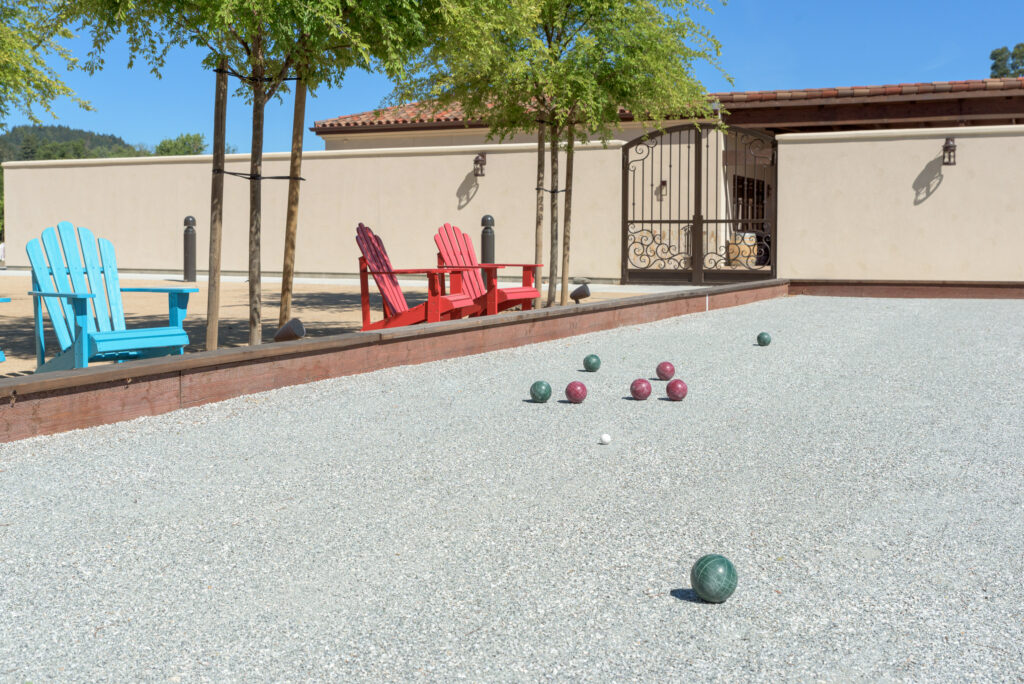
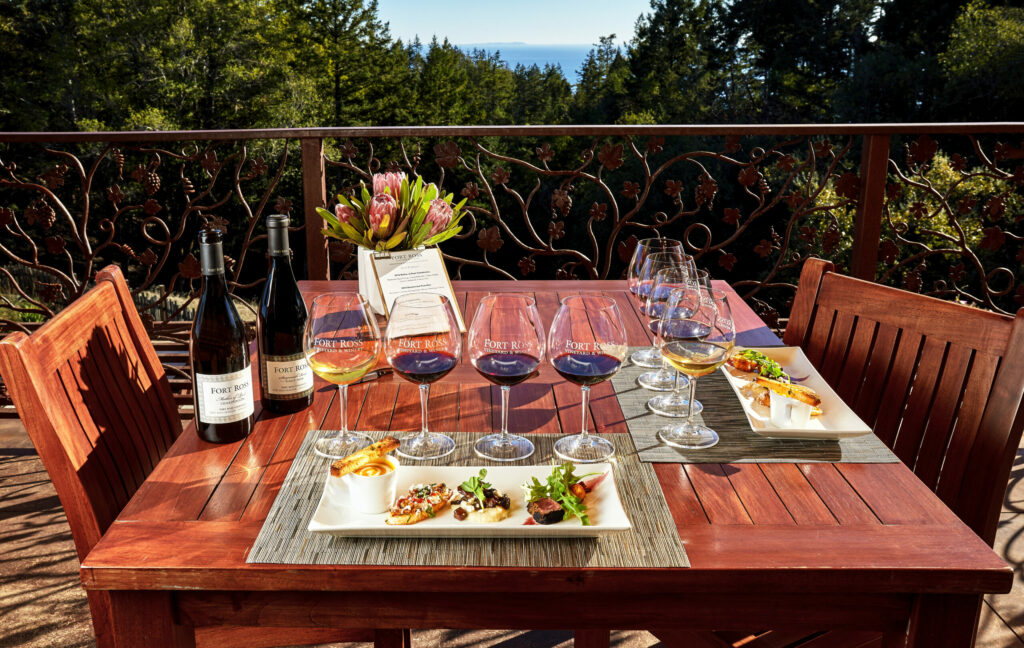

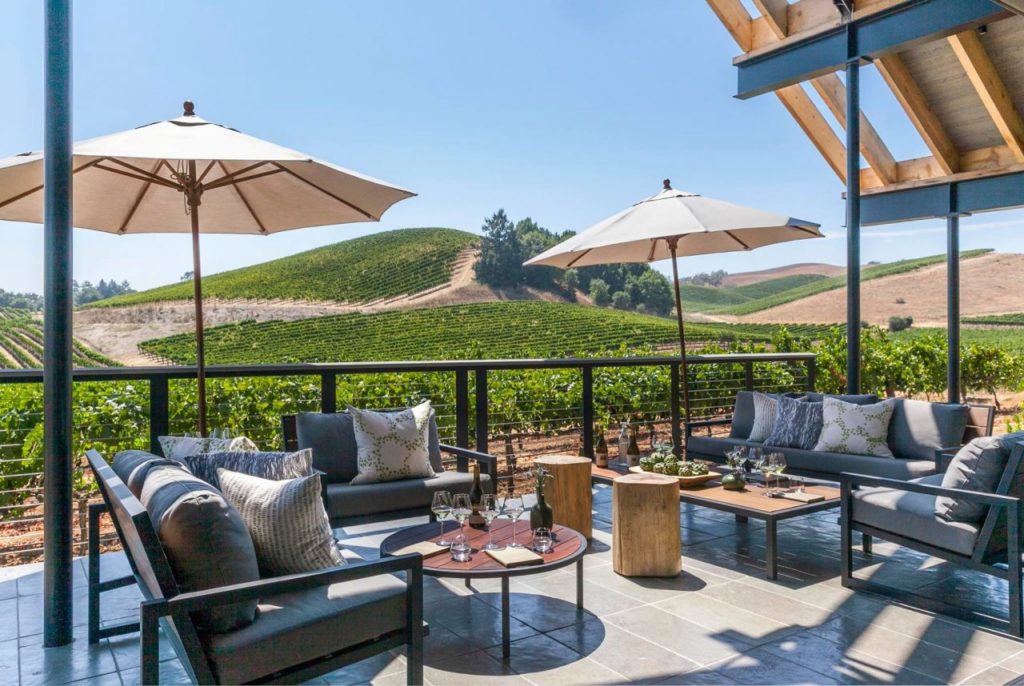

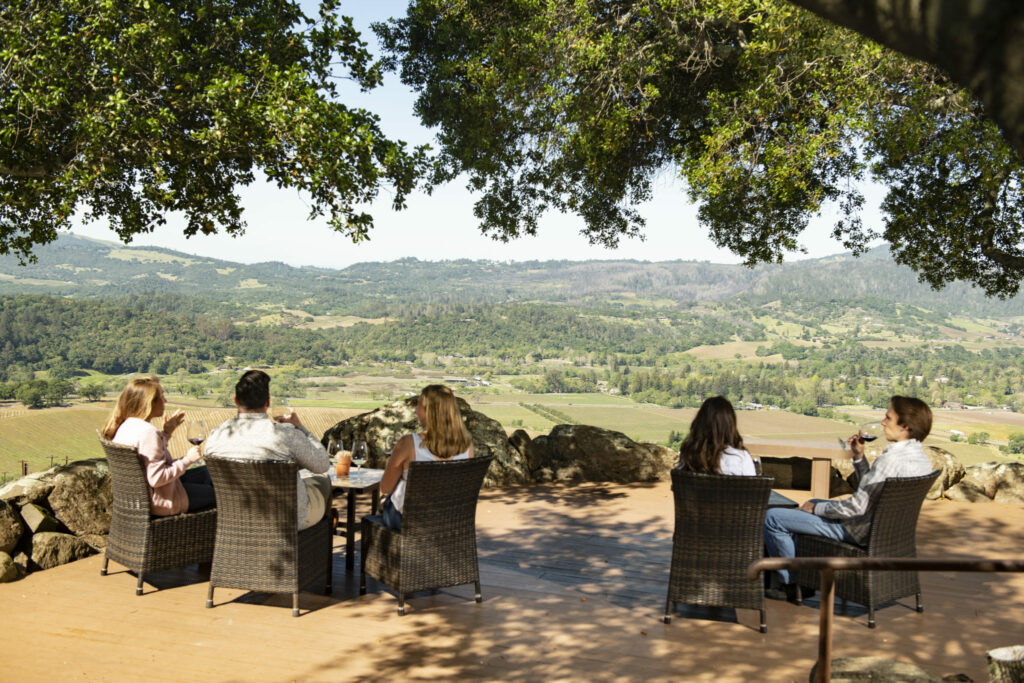
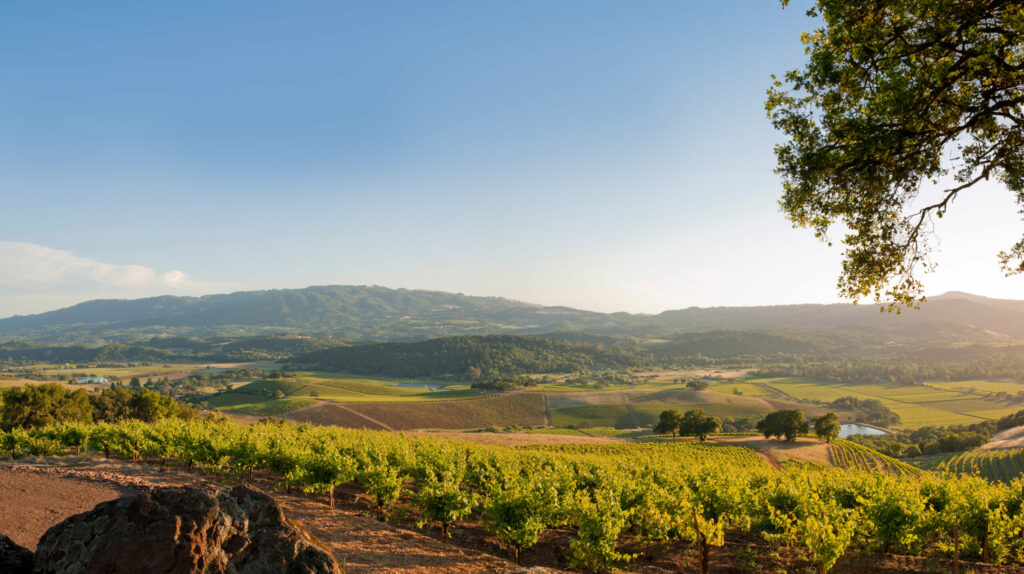
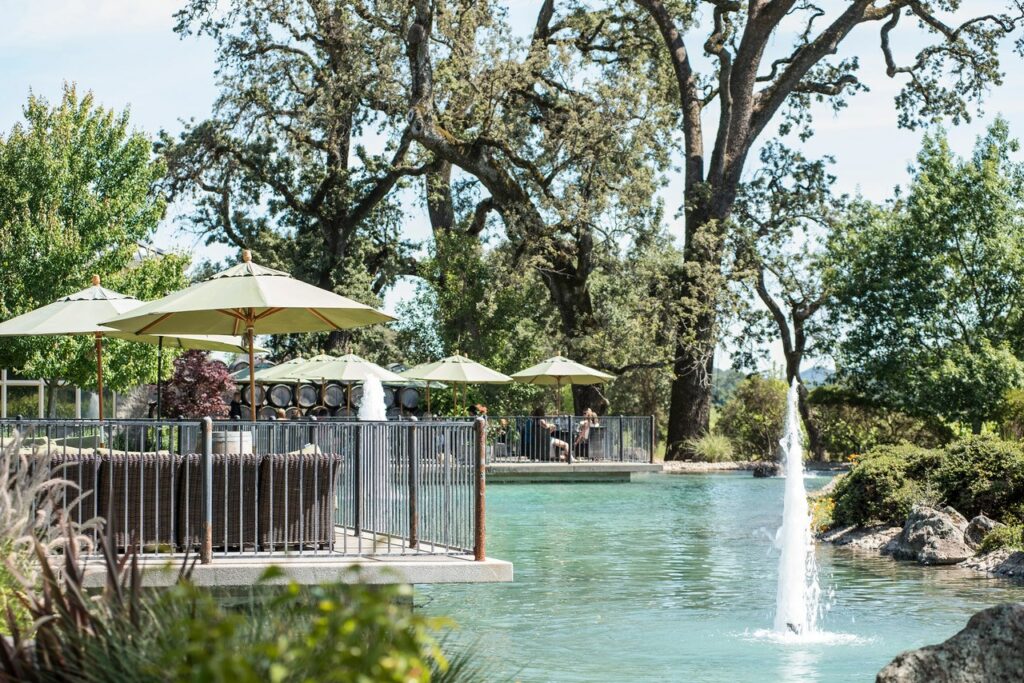

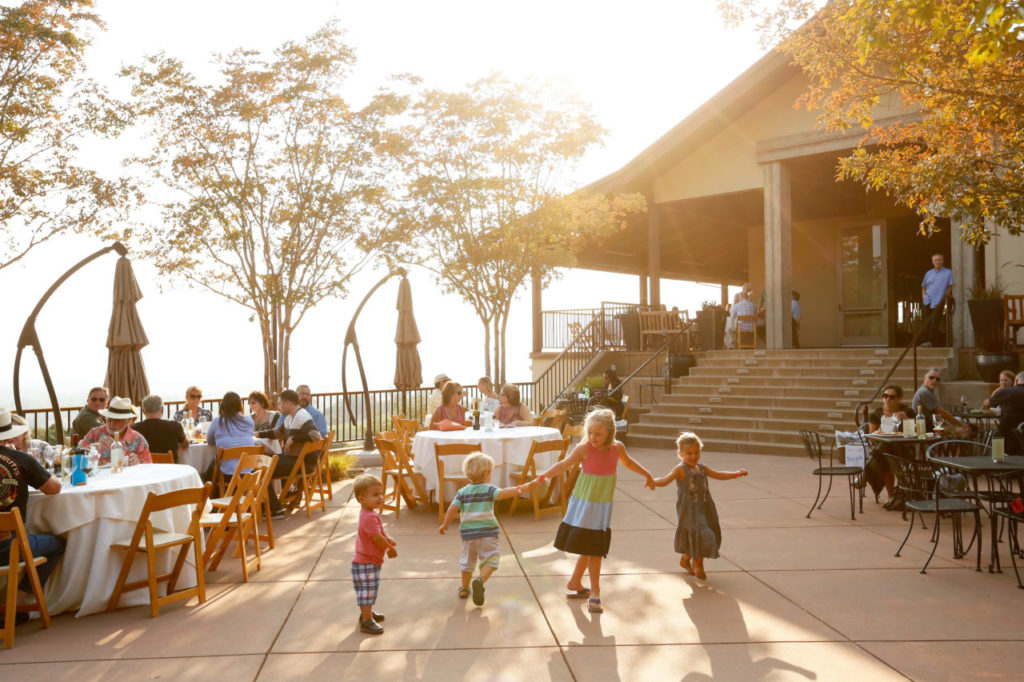
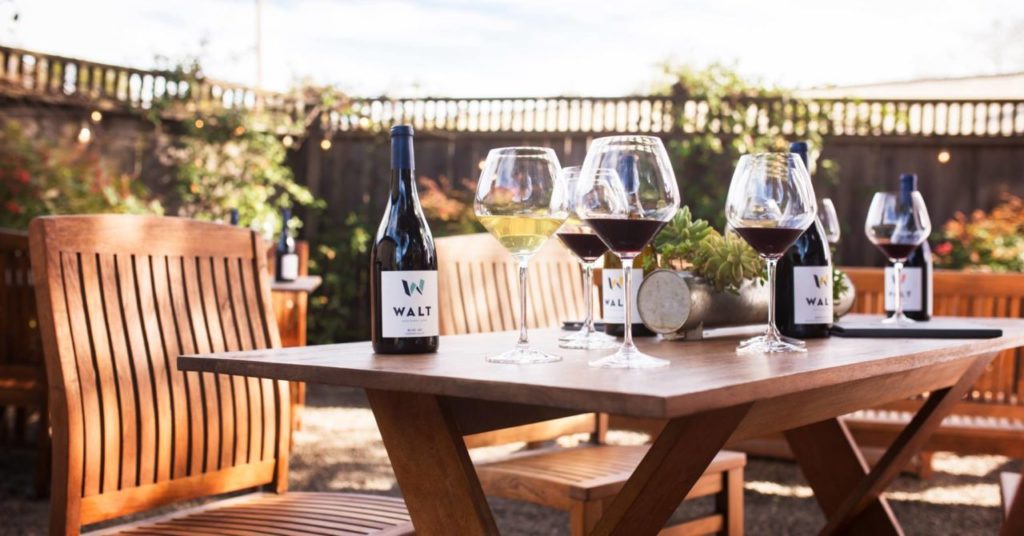
Sip in the sun this summer at one of Sonoma County’s stunning winery patios, where sun-dappled outdoor spaces give way to breathtaking panoramic views of vineyards and valleys.
Check out our roundup of six favorite winery patios in the county to try this summer, from enchanting mountain-top tastings to coastal spots with Pacific views.
Healdsburg
Bacchus Landing
Home to more than a half dozen small, family-run wineries pouring their wines in five separate tasting rooms, each has lovely outdoor patio space—plus, there are bocce courts and places to picnic. 707-395-0697, bacchuslanding.com
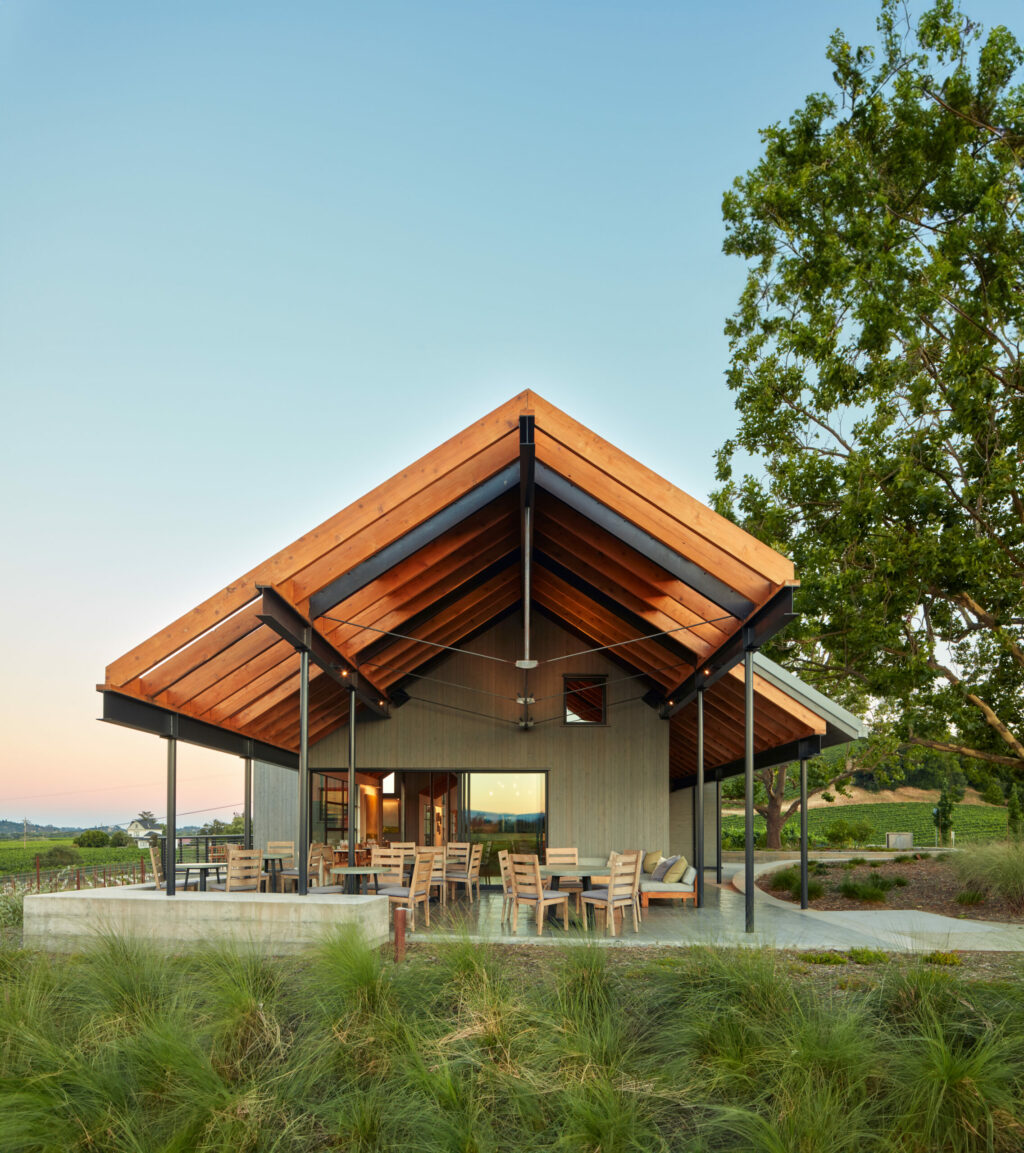
MacRostie Winery
Enjoy photo-worthy panoramas from one of three patios at the MacRostie Estate House. The winery’s Signature Experience includes five wines, with a focus on single-vineyard Chardonnay and Pinot Noir from the Russian River Valley and Sonoma Coast. 707-473-9303, macrostiewinery.com
Jenner
Fort Ross Vineyard & Winery
On clear days, the back deck at this coastal winery offers dreamy views of the Pacific Ocean, coastal redwoods, and lush meadows. Wine tastings are accompanied by small bites prepared by the estate chef. 707-847-3460, fortrossvineyard.com
Kenwood
Kunde Family Winery
Enjoy vineyard and water fountain views from the valley floor on the Kinneybrook Patio. Or head up to the summit: The mountain top tasting is totally worth it, with views for miles. 707-833-5501, kunde.com
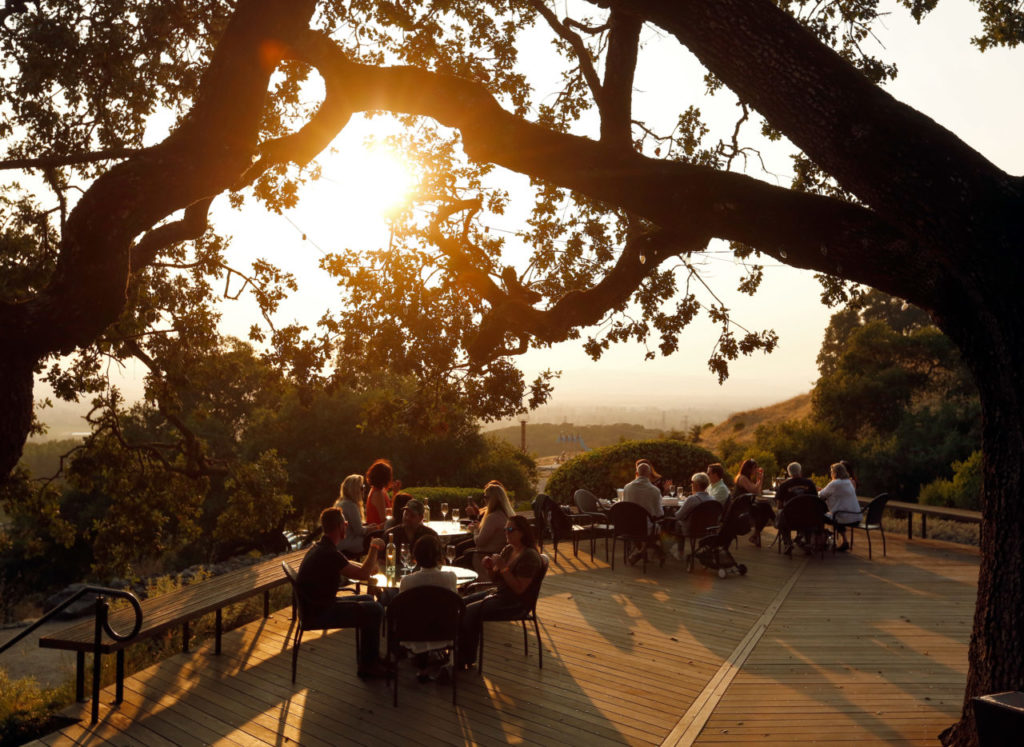
Santa Rosa
Paradise Ridge Winery
It’s hard not to fall in love with the views from this winery patio, with a sprawling large-scale outdoor sculpture garden and some of summer’s best live music, the popular Wine & Sunsets series. 707-528-9463, prwinery.com
Sonoma
WALT Wines
Just steps from the historic plaza, WALT touts Pinot Noir and Chardonnay from vineyards throughout California. Our favorite here is the wine and chocolate pairing, with the delightful sugar rush coming courtesy of Windsor’s Fleur Sauvage Chocolates. 707-933-4440, waltwines.com
The post 6 Favorite Winery Patios in Sonoma County appeared first on Sonoma Magazine.
]]>
The Museum of Sonoma County’s new show juxtaposes the story of hop growing in the county with the history of Sonoma’s craft brew revolution.
The post Tap Into Sonoma County’s Craft Beer Revolution at New Exhibition appeared first on Sonoma Magazine.
]]>












The Museum of Sonoma County’s new show, “On Tap: Sonoma County Hops and the Beer Revolution,” juxtaposes the story of hop growing in the county with the history of Sonoma’s craft brew revolution.
The two industries peaked at opposite ends of the 20th century, with local hops nearly disappearing just a few decades before the surge of interest in artisan beer making, which started in 1976 with New Albion Brewery, widely acknowledged as the nation’s first craft brewery.
The exhibition follows widely divergent threads of the industry, from the stories of Chinese workers growing and harvesting hops in the early 1900s, to labor unrest in the 1930s, to today’s landmark craft brewers and small-scale hop growers, who have made Sonoma County into a hot bed of beer-making innovation.
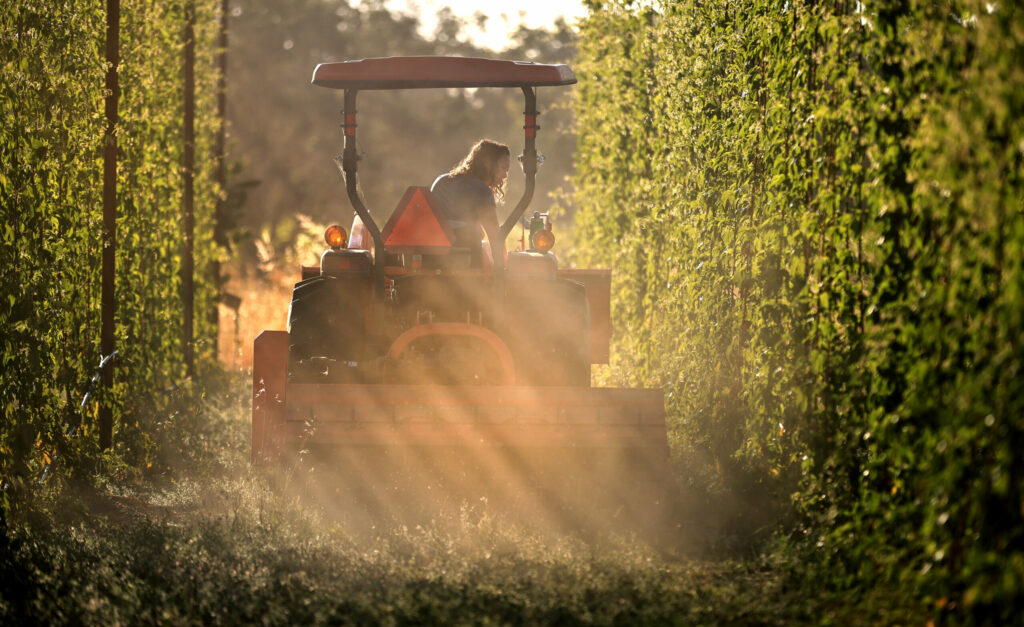
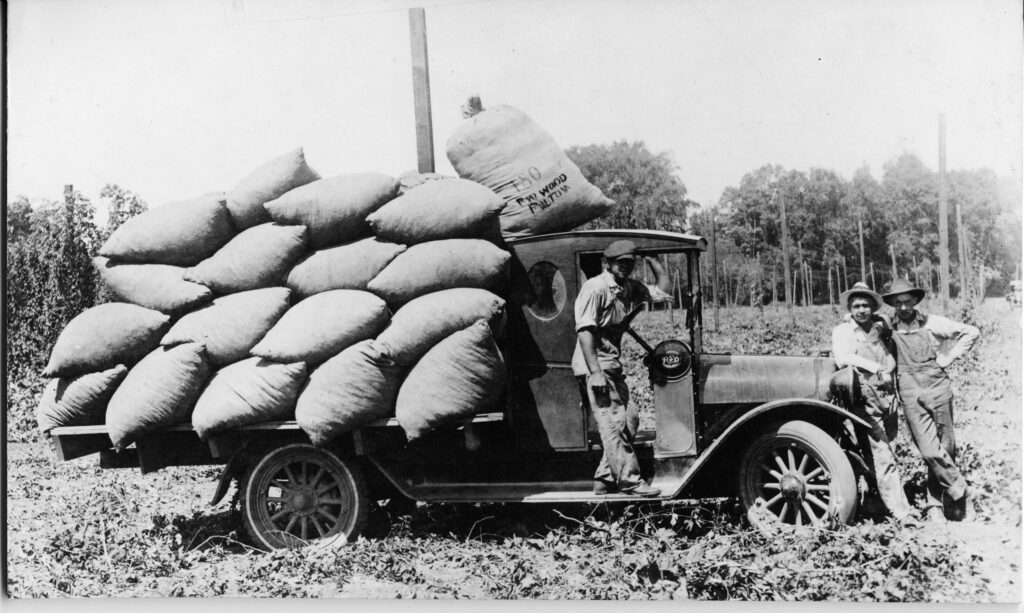
“There are so many arcs to this story, and it all connects,” says museum curator Eric Stanley. “You realize how distinct and intense and important hop growing was to the county and how quickly it nearly disappeared, just as craft beer was becoming so important.”
The exhibit includes a huge, modern hop-picking machine on display (“the only one that would fit in the building,” jokes Stanley), vintage videos of the local hop harvest, and interactive sniffing stations that explore the aromatics of different hop varieties.
The museum will host talks and demonstrations over the summer, including a “Legends of Beer” panel discussion and a big tasting event outdoors in the museum’s sculpture garden on July 20.
Through Sept. 1. Museum of Sonoma County, 425 Seventh St., Santa Rosa. 707-579-1500, museumsc.org
The post Tap Into Sonoma County’s Craft Beer Revolution at New Exhibition appeared first on Sonoma Magazine.
]]>
Find this summer's most delicious pop-ups in Sonoma County — from burgers and birria to riffs on classic Chinese cuisine.
The post Sonoma County Food Pop-Ups Worth Finding This Summer appeared first on Sonoma Magazine.
]]>












Food trucks may have rolled up into our hearts, but tent hawkers and pop-up provisions are the next frontier in ultra-casual cuisine. These creative cooks thumb their noses at tradition, change menus on a dime, and constantly experiment with new ideas.
You’ll find them at breweries and wineries, outside gyms, or wherever hungry people congregate. But don’t try to find them by phone or address; you’ve got to be on social media to catch them.
Whiz Kids
Golden Steak Warriors
Sonoma County has finally (finally!) seen the golden light of Cheez Whiz and grilled steak on an Amoroso roll, Philly-style. This husband-and-wife team pop-up at spots like Maison Healdsburg and local wineries with their oooey, gooey noshes. instagram.com/golden_steak_warriors
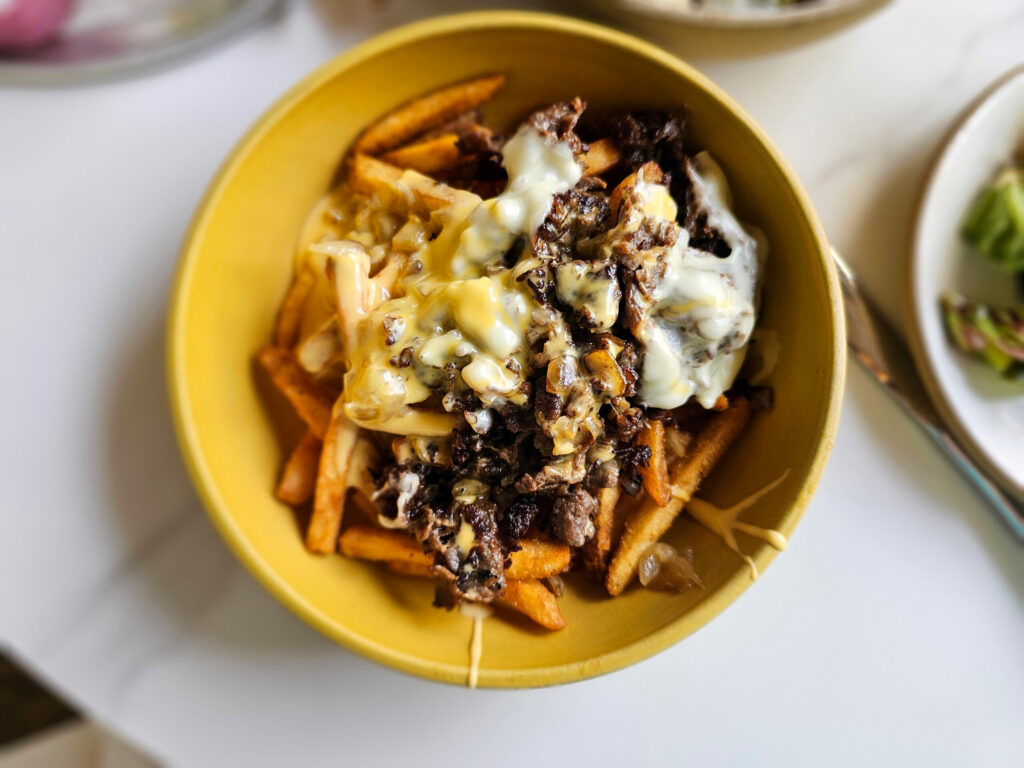
Eclectic Chef
Half Hitch
Though officially based in Tomales, chef Amelia Telc brings her skills to The Casino in Bodega and other Sonoma County pop-up spots frequently. Korean and Chinese cuisine strongly influence the menus of the SF Mission Chinese alum, though she’s well-versed in European standards as well. instagram.com/halfhitch_tomales
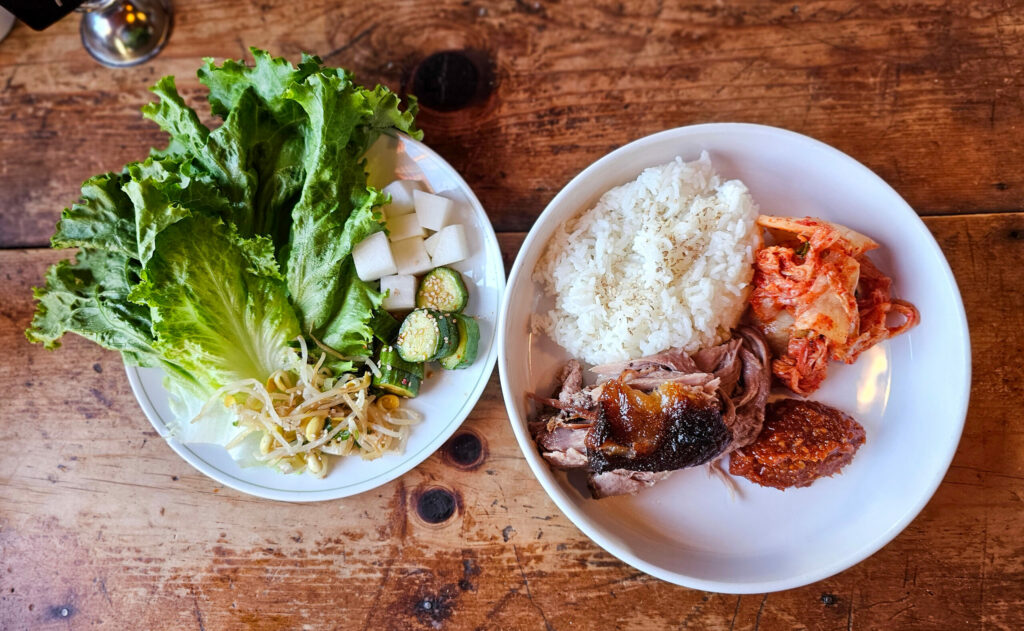
Underground Chinese
The Matriarch
An offshoot of fried chicken pop-up favorite Second Staff, this new iteration in their constantly morphing culinary adventures riffs on classic Chinese cuisine, including soup dumplings and gai-lan. Like all of their offerings, it’s usually a late-night thing, going past midnight. instagram.com/_secondstaff
Haute Dogs
HILO Burgers
Deeply delicious (and messy) smash burgers, chili cheese dogs, and fries are their jam. They’re mostly a Healdsburg thing, with the BloodRoot tasting room and Molti Amici as their regular (but irregularly scheduled) haunts. instagram.com/hilo_burgers
High Design
Barsace
Frequently found around Healdsburg in cahoots with HILO Burgers, hip-tastic cocktail creations feel straight out of a Wes Anderson film. Otello Tiano, the former bar director at San Francisco’s Michelin-starred Lazy Bear, garnishes his Desert Disco rum/bourbon creation with a blood-orange peel in the shape of a lightning bolt. instagram.com/barsace_
Mooving Tribute
Bayou’s Burgers and Birria
A spin-off of California-Cajun favorite Bayou on the Bay with—you guessed it—burgers and birria. Chefs Bradley and Mandy sling some serious beef, using locally raised Scottish Highland cattle. Often found at breweries or outside Santa Rosa’s Session Climbing. instagram.com/bayousburgerbirria
The post Sonoma County Food Pop-Ups Worth Finding This Summer appeared first on Sonoma Magazine.
]]>
Learn more about local gold medal-winning winemaker Dennis McCarter — and check out four of his wines to try.
The post Sonoma County Winemaker Wins Top Award at Prestigious Wine Competition appeared first on Sonoma Magazine.
]]>












Dennis McCarter cried when he learned that his 2022 Forchini Pinot Noir won a double-gold medal at the 2024 San Francisco Chronicle Wine Competition. It’s not that he didn’t believe it was a well-made wine; he just didn’t expect to land a top award so soon after releasing his first McCarter Cellars wines in 2023.
“It was a shocker,” says McCarter. “You kind of have impostor syndrome, where you wonder, ‘Am I doing the right things? Do I even belong in this industry?’ But when I got the news about the award, I was like, ‘Oh my gosh, I think this solidifies it. I belong here.’”
While McCarter’s eponymous label is new to the scene, the Santa Rosa native has been making wine for more than a decade. When he was just 21 years old, a food-pairing class at Santa Rosa Junior College turned him on to wine. He got his first taste of the production side at Sunce Winery in the Russian River Valley, where he volunteered to help with everything from harvest to bottling.
McCarter purchased grapes and made his first garage wines in 2010 while working in the insurance business.
“When I introduced the wines to my friends, they went crazy,” he recalls. “Normally, when people hear ‘garage wine’ they head for the hills.”
He began entering his wines in the amateur category at the Sonoma County Harvest
Fair—and started winning awards.
He finally decided to go pro in the aftermath of the 2017 wildfires. McCarter sold his insurance agency and signed on for an internship at Vinify Wine Services in Santa Rosa, where he found a mentor in Matt Duffy of Vaughn Duffy winery.
After taking a break to study enology at SRJC, he returned to Vinify as an assistant winemaker and launched McCarter Cellars with the the double-gold-winning Forchini Pinot Noir and a Sauvignon Blanc. This year, he’ll release his first dry Gewürztraminer and the 2023 Pink*ish rosé. His wines are now carried at Bottle Barn and at several top Santa Rosa restaurants, including Grossman’s and Jackson’s Bar and Oven.
McCarter is involved in organizing events to lift up the work of other Black winemakers. He’s organizing a Juneteenth event to celebrate trailblazer Mac McDonald of Windsor’s Vision Cellars, who is now in his 80s. And when McCarter’s not talking wine, he teaches judo to underserved youth and serves on the board of the Rohnert Park Community Round Table, which helps improve relationships between law enforcement and communities of color. mccartercellars.com
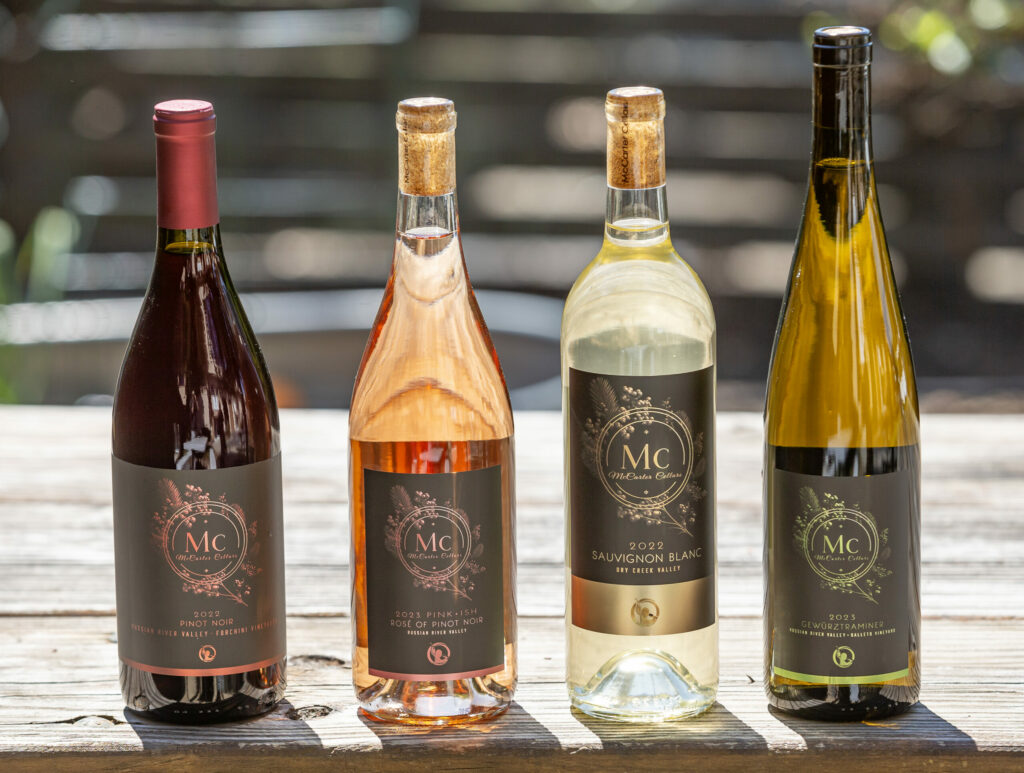
McCarter Cellars 2022 Forchini Pinot Noir, $48
A 98-point Best of Class double-gold winner at The Press Democrat’s 2024 North Coast Wine Challenge. “The compliment I get is that this is an Old World approach,” says McCarter. “It’s a bit lighter in color but with a rich mouthfeel—definitely exceeding expectations. I love it with pork chops, grilled chicken, couscous with raisins and dried cherries.”
McCarter Cellars 2023 Gewürztraminer, $29
This is McCarter’s first time working with this variety, which arrived in the winery relatively early and was foot stomped, then given 24 hours of skin contact. “It’s got a rose petal aroma, lychee, and a nice little bit of pineapple on the palate. I love it with Thai food and al pastor tacos.”
McCarter Cellars 2023 Pink*ish Rosé of Pinot Noir, $25
McCarter has almost sold out of his 2022 rosé and will release the 2023 soon. It’s made using the saignée method, with lovely strawberry and floral notes. “It’s a wine I’d want to enjoy at the beach or out by the pool,” he says.
McCarter Cellars 2022 Sauvignon Blanc, $38
McCarter got only a ton of this fruit, and it’s special, he says, with flavors of lime, Asian pear, and gooseberry, and lovely acidity. “I think of being out at Bodega Bay, enjoying it at the beach with a plate of oysters—or fish tacos or ceviche.”
The post Sonoma County Winemaker Wins Top Award at Prestigious Wine Competition appeared first on Sonoma Magazine.
]]>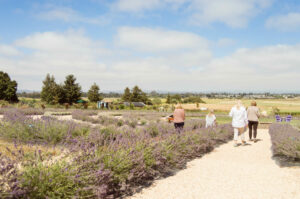
Sonoma County’s public gardens and nurseries come alive in early summer. Check out some of our favorite local gardens in bloom.
The post Discover the Beauty of Sonoma County’s Public Gardens This Summer appeared first on Sonoma Magazine.
]]>












Sonoma’s public gardens and nurseries come alive in early summer, with a bounty of blossoms both rare and recognized. Make a day of it with your loved ones — for Mother’s or Father’s Day, a special graduation or just because.
Check out some of our favorite local public gardens below, as well as a preview of the vibrant blooms in store in the gallery above.
For rare Asian plants
Sonoma Botanical Garden
Glen Ellen
Founded in 1987 from wild seeds collected on plant expeditions all over Asia, the gardens here showcase an expansive collection of species, including many native plants from California in addition to the Asian collections. A focus on conservation has long been a part of Sonoma Botanical Garden’s ethos. Through August, the Ribbit Exhibit is a whimsical and family friendly show of largescale copper frog sculptures scattered throughout the gardens, and there’s a new native plant demonstration garden, too.
12841 Highway 12, Glen Ellen. sonomabg.org

For secret pathways
Hidden Forest Nursery
Sebastopol
With 2 miles of trails that wind through the 7.5-acre reserve, Hidden Forest Nursery feels like a magical secret garden—and a top nursery where gardeners can purchase rare varieties of rhododendrons, azaleas, camellias, and Japanese maples. Guided docent tours are available the first and third Saturday morning of each month.
3970 Azalea Lane, Sebastopol. 707-823-6832, hiddenforestnursery.com
To wander a labyrinth
Bees N Blooms
Santa Rosa
It’s a lavender wonderland at this sunny garden on the Santa Rosa plains. Bring a picnic, watch the baby geese, and wander a labyrinth planted with different varieties of lavender timed to bloom in the early, middle, and late season. The farm’s annual Lavender Daze visits, which require an advance ticket, start May 18. New this year, the farm stays open certain evenings for sunset lavender-viewing.
3883 Petaluma Hill Road, Santa Rosa. 707-293-8293, beesblooms.com

The dreamiest lavender
Monte-Bellaria di California
Sebastopol
There is nothing quite like the purple of a lavender field in prime bloom. Monte-Bellaria considers the time through mid-June as their “green season,” and they’re open Saturdays and Sundays, usually without an advance ticket. Starting in mid-June, the “high bloom” season, you need to purchase advance-timed tickets online. It’s worth it, though—the sweeping hillside gardens are extraordinary, and there are olive groves and beehives to learn about as well.
3518 Bloomfield Road, Sebastopol. monte-bellaria.com
For Mother’s Day
Garden Valley Ranch
Petaluma
Other than snagging an invitation to a wedding (the 5-acre ranch hosts some of the prettiest events in the county), our favorite way to experience these gardens is visiting for Mother’s Day, when the ranch opens to families for flower foraging and BYO picnics at tables set with linen cloths and surrounded by blooms. There’s also a cottage that can be booked for overnights.
498 Pepper Road, Petaluma. 707-7950919, gardenvalley.com
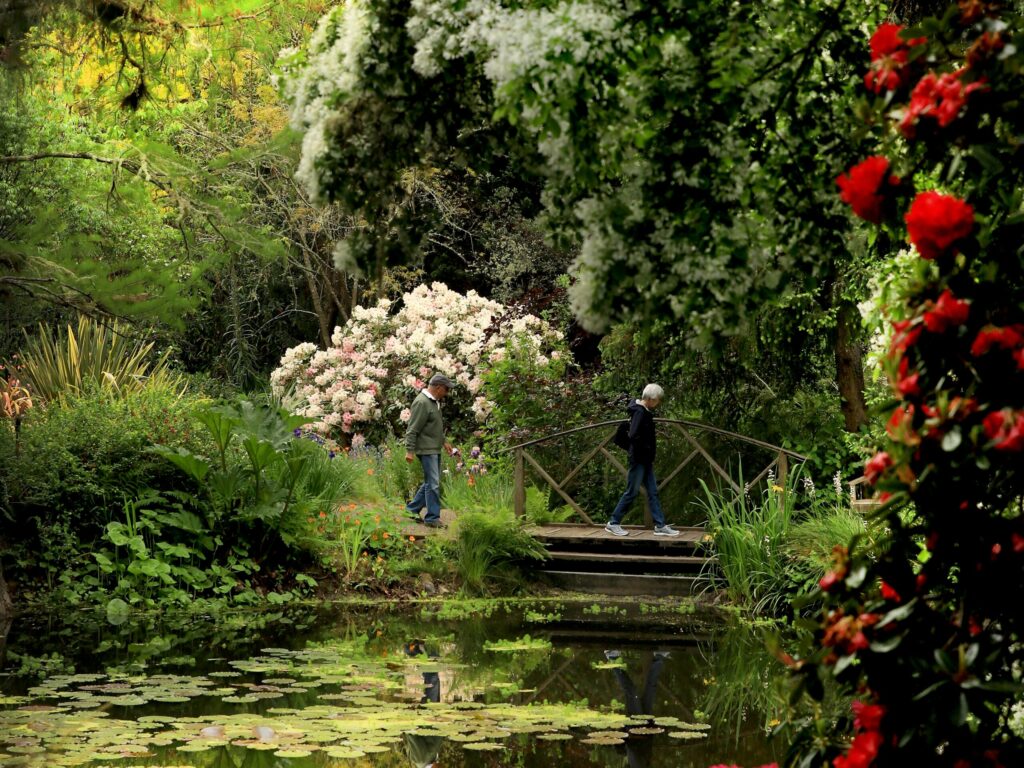
For community and art
Western Hills Garden
Occidental
In 2022, Hadley Dynak and Kent Strader purchased this 3-acre historic garden, first planted over 60 years ago. The couple, their friends, and local volunteers are gently remaking the spaces and bringing in new ways to gather. In May, the owners will host a series of classes on cyanotype printmaking, and earlier this spring, they paired up with Occidental foodie favorite Morihouse to offer an equinox meal of rice, green tea, tofu, and foraged herbs.
16250 Coleman Valley Road, Occidental. westernhillsgarden.com
The post Discover the Beauty of Sonoma County’s Public Gardens This Summer appeared first on Sonoma Magazine.
]]>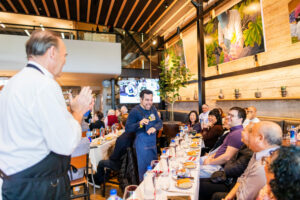
Events include a rock climbing benefit gala, a wine and food pairing with an Iron Chef-style cook-off, and an awards show for sustainable businesses.
The post Party Pix: These Sonoma County Events Went All Out for the Community appeared first on Sonoma Magazine.
]]>












Benefit galas, annual awards shows and food and wine pairing events this year have raised money for and celebrated multiple organizations in Sonoma County.
Check out the events the county has hosted this past spring that recognized impactful organizations and raised thousands for notable causes.
Santa Rosa
Climb 2 Recovery
On March 16 in Santa Rosa, internationally known rock climber Kevin Jorgeson welcomed 130 guests to the second annual Climb 2 Recovery gala to benefit Women’s Recovery Services, a Santa Rosa nonprofit that offers addiction recovery services for pregnant and parenting women. The event raised over $120,000.

The event was held at Session Climbing, the Santa Rosa gym Jorgeson founded in 2022, and featured climbing demonstrations, speakers and a live auction. The meal was provided by Park Avenue Catering in Cotati, and the auction included donations from Catelli’s Restaurant, Bricoleur Vineyards, Vérité Winery, Cline Cellars, Russian River Brewing and more. Trione Vineyards & Winery and Redwood Credit Union were among the sponsors.
The program included reflections from three women who had been given climbing instruction from Session staff members and later climbed to the top of Goat Rock on the Sonoma Coast. Their climb was captured in a video that played at the event.
“There’s not a dry eye in the house when you see the recovery and reclamation of life,” says Women’s Recovery Services executive director Diane Madrigal. “There was a standing ovation for them acknowledging their hard work and determination to change their lives.” womensrecoveryservices.org
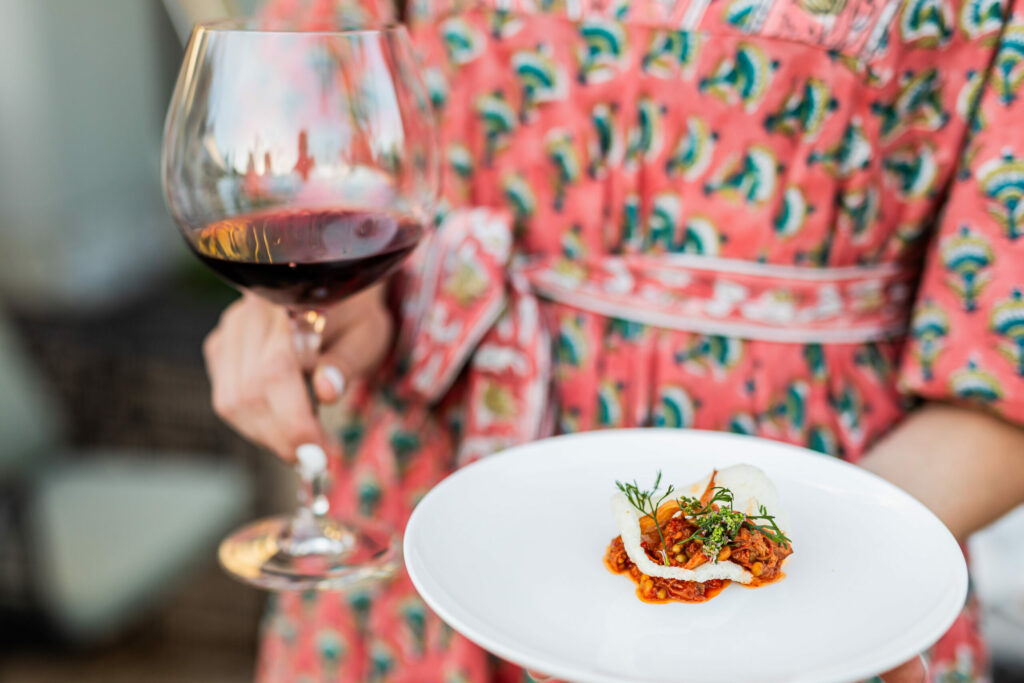
Healdsburg
Pigs & Pinot
It was another fun weekend of tastings and gourmet meals at the 17th annual Pigs & Pinot celebrations, hosted by chef Charlie Palmer of Dry Creek Kitchen at locations around Healdsburg March 15-16.
The event raised over $150,000 for scholarships for culinary, wine, and hospitality students at the Culinary Institute of America and Sonoma State University, as well as scholastic music and arts programs in Healdsburg, Cloverdale and Santa Rosa.
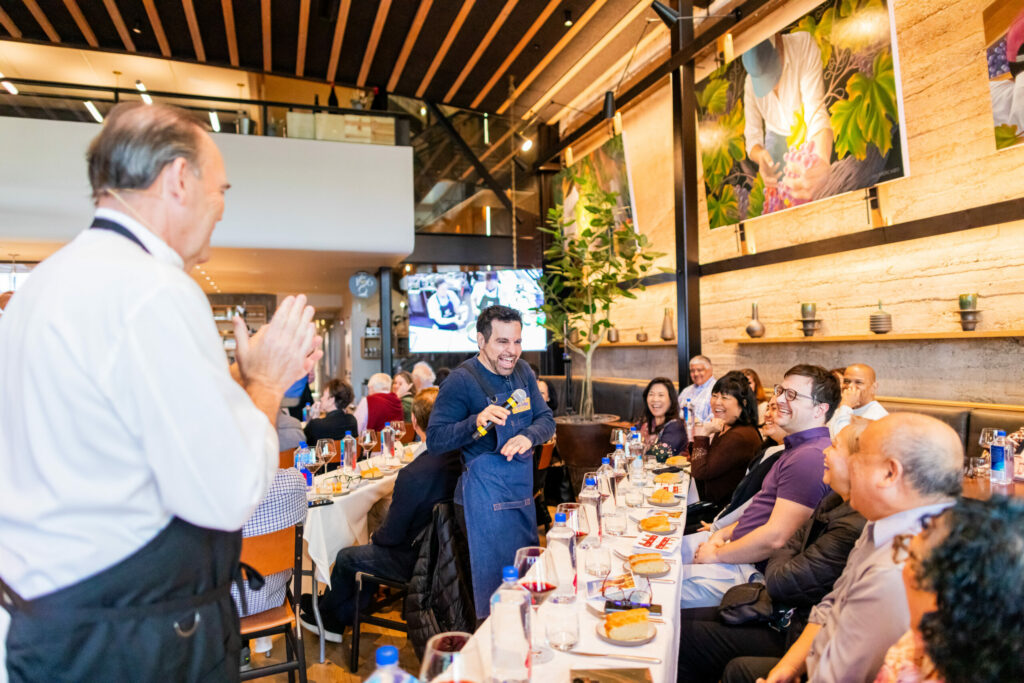
Palmer rallied chef and winemaker friends to present a multi-day program of seminars, tastings and gala dinners, including an Iron Chef-style cook-off hosted by actor Mario Cantone as well as two different Pinot Noir tasting challenges.
“This was the greatest Pigs and Pinot yet,” said Palmer.“It’s now all about our Sonoma County hospitality community.”
Winemakers Ashley Holland of Read Holland Wines (a Sonoma Magazine “Winemaker to Watch” in 2021), Jeremiah Timm and Michael Browne of CHEV wines, and Todd Kohn of Wayfarer Vineyard took home top Pinot Noir prizes. pigsandpinot.com
Sebastopol
Slow Food’s Snail of Approval awards
A dozen Sonoma County restaurants, farms, and artisan producers were recognized for their sustainable and locally made food at the sixth annual Snail of Approval awards Feb. 28 at the Sebastopol Grange.
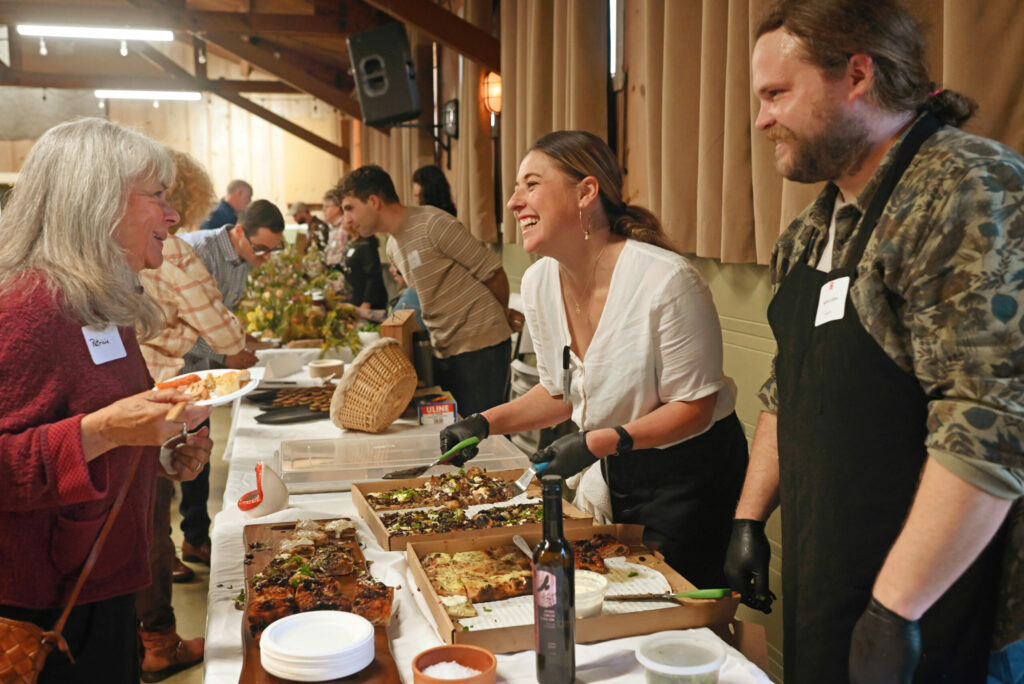
Presented by the Sonoma County North and Russian River chapters of the national nonprofit Slow Food USA, over a hundred guests enjoyed samples of the winners’ food and wines before the ceremony.
“Part of our mission is to get the community involved to learn about these food businesses that are supporting local agriculture and local products and treating their employees well,” says Carol Diaz of Slow Food Sonoma County North.
The event recognized Sarmentine Artisan Boulanger, Fourteen Magpies Handmade Jams & Preserves, Goguette Bread, The Spinster Sisters, the culinary farm at St. Francis Winery & Vineyards, SingleThread Farm, Americana, Psychic Pie, The Bejkr, Bricoleur Vineyards Culinary Garden, Volo Chocolate and Wise Acre Farm. slowfoodsonomacountynorth.org
The post Party Pix: These Sonoma County Events Went All Out for the Community appeared first on Sonoma Magazine.
]]>
Sonoma County’s Board of Supervisors takes up the issue over home-based restaurants later this year.
The post Economic Boost or Neighborhood Nuisance? The Battle Over Sonoma Home Restaurants Continues appeared first on Sonoma Magazine.
]]>












In September, Sonoma County’s Board of Supervisors will consider whether to issue permits to residents who would like to cook and serve meals from their private homes, or to people who would like to use their homes as commissary kitchens.
For some, home-based restaurants represent a challenge to neighborhood peace and quiet. But for others, a home-based restaurant is a low-cost first step into a notoriously challenging industry with high barriers to entry—a way to experiment with ideas or perhaps bring in some extra cash.
This particular type of business is known as a MEHKO, or microenterprise home kitchen operation. MEHKOs are allowed under a California law passed in 2018 which permits the preparation, sale, and consumption of meals from a person’s home—if (and it’s a big “if”) the person lives in a county that has decided to opt into the MEHKO program.
Right now, Sonoma is one of approximately 40 counties in the state which have yet to opt in. According to The Institute for Justice, a public interest law firm that has advocated for the adoption of MEHKO legislation, just 30% of Californians currently live in a county where they can participate in the MEHKO program.

Dawn Zaft of Santa Rosa is one of the Sonoma food business owners for whom MEHKO might have made a difference. In early 2012, Zaft started baking on a small scale in her home, unpermitted and on the down-low, to make some extra money. The name she chose for her micro-operation— Criminal Baking—was a mix of tongue-in-cheek humor and radical honesty.
“And then immediately I was like, ‘Oh, I probably shouldn’t do that; I’m gonna attract the wrong kind of attention.’ But it ended up being that the name really served me,” she says.
Zaft initially baked only for the cafe where she was already working part time as a barista. She didn’t make much money, but her entrepreneurial skills grew—and that meant legitimizing her operations.
In 2012, California passed AB 1616, the California Homemade Food Act, a different bill which allows people to prepare, package, and sell certain types of foods from a private home kitchen. As the bill passed, Zaft says she got the proper permits and moved into a commercial kitchen space nearby. And from there, her business has continued to grow.
These days, Criminal Baking is a fixture of Santa Rosa’s food scene, with a permanent cafe in the West End neighborhood, where Zaft has become known for her savory and sweet pies and towering breakfast sandwiches. She’s expanding her Sunday supper service, too. Zaft’s early side hustles provided an important path into the restaurant business.
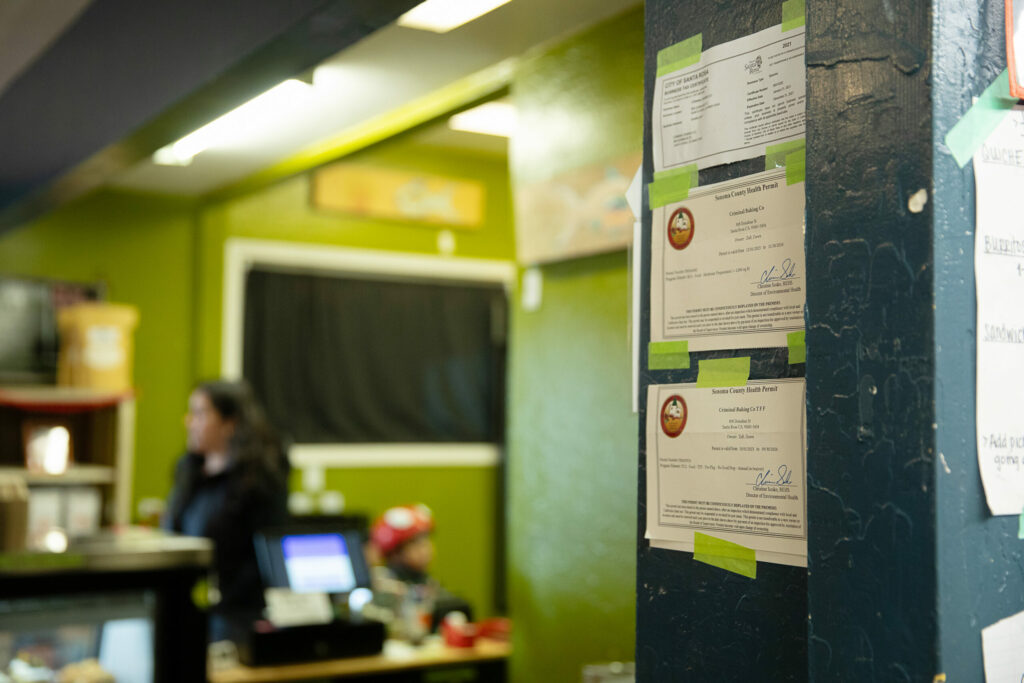
Supporters of MEHKOs say that they’re an important way for small-scale entrepreneurs like Zaft to innovate and test the market, and that not everyone can afford to start a restaurant through traditional means—especially here in Sonoma County, where rent and other start-up costs can be prohibitively expensive, particularly in the long shadow of the pandemic.
And MEHKOs can be a good source of income. Under the law, operators are allowed to earn up to $100,000 per year and sell up to 30 meals per day, with a further limit of 90 meals per week. And MEHKO permit holders are allowed to prepare and sell more kinds of foods than is allowed with a cottage food operation permit.
Santa Rosa’s Jeremy Clemens started his pizza pop-up, Gabacool Provisions, just after the pandemic, when he realized he no longer wanted to invest 96 hours a week running a business for someone else.
“What if I put that energy into doing something for me, you know?” he explains. “Pizza is something I still find fun. And every, every bit of it is a challenge.”
The name of the business, which Clemens co-owns with his partner, Michele Querin, is a nod both to Clemens’ Italian-American heritage and an insider reference to one of his favorite TV series, “The Sopranos.” And who’d know better about keeping things quiet than the mob?
Clemens first made test pizzas in his kitchen, focusing on his dough recipe—at first, a sourdough, then a yeasted dough. He tracked everything, from the grams of flour in the sauce to the ratio of salt in his homemade tomato sauce.
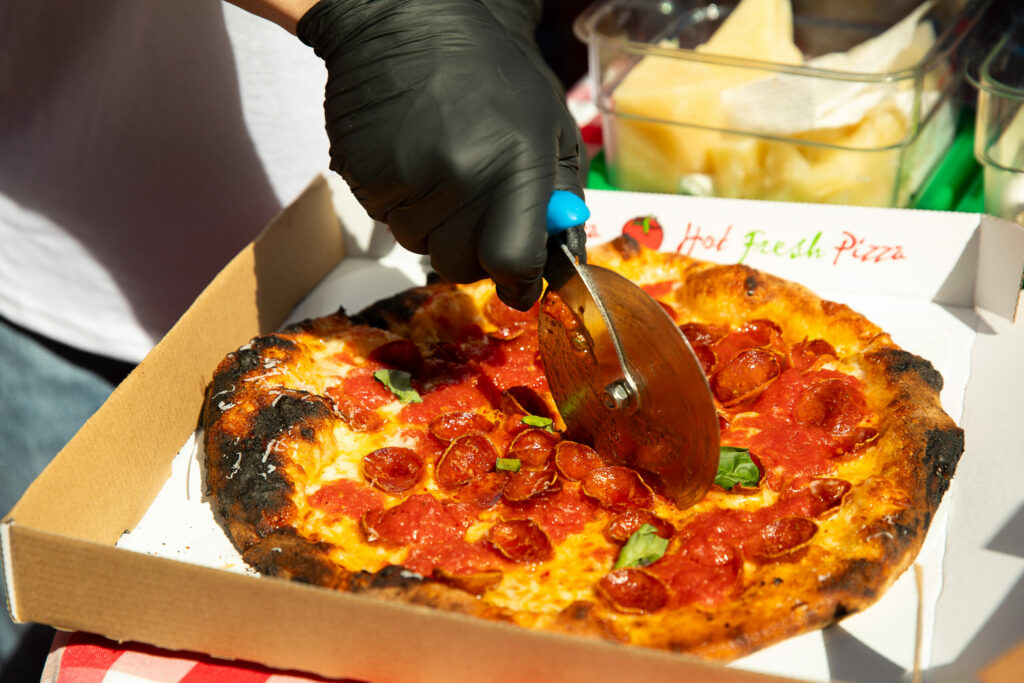
In August 2022, he left a position as executive chef at The Stavrand Russian River and went into full-on pizza mode. He held pop-ups for his Detroit-style pizza, until recently without any kind of permit, encouraging people to keep it “on the DL.” And like Criminal Baking, Gabacool Provisions is now a permitted business, though Clemens still works another job for additional income.
Private chef David Mau, who splits his time between Southern California and the Russian River area, has worked in professional kitchens for decades and has a good sense of the costs and pitfalls of opening a traditional brick-and-mortar restaurant. Mau believes that for most smaller operators, there’s little money to be made in owning a traditional restaurant: he says opening a brick-and-mortar restaurant could cost a million dollars or more—and even if running a tight ship, most owners or investors can expect profit margins of less than 10%.
Mau has found his niche as a private chef, working in private homes or vacation rentals for small groups of eight to 20 people. He thinks the difference between his work as a licensed and permitted private chef and someone operating a MEHKO is simply a matter of semantics.
“It’s basically the same experience,” Mau says.
Opponents of MEHKOs raise concerns over noise and parking and point out that there are other options for those who would like to start a small food business at a low cost, such as sharing a kitchen space or starting out with a mobile food cart, pop-up or food truck.
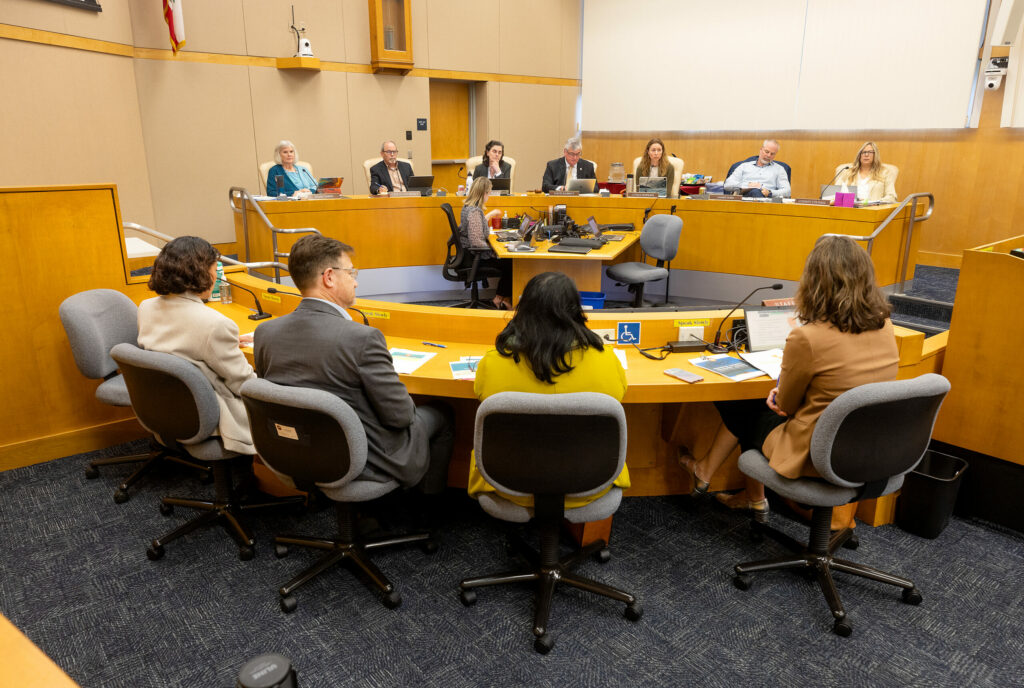
A 2019 push to approve MEHKOs in Sonoma County was led by local advocates and supervisor Lynda Hopkins. Their efforts fizzled after a Board of Supervisors meeting was bogged down over concerns about noise and parking in neighborhoods, as well as technical questions about environmental regulations and grease traps.
Hopkins helped place the issue back on the agenda this coming September. “I wish it were sooner; it feels like a long time to wait,” she says.
In 2021, local city managers were contacted by the county for feedback on the possible adoption of MEHKO legislation. Santa Rosa and Petaluma were in support of the program, but other city managers wrote back with concerns over safety code compliance, land use impacts, enforcement concerns and the impact on existing businesses.
Sebastopol’s planning director expressed concern over whether MEHKOs might increase vacancies in the city’s commercial districts. And Rohnert Park’s city manager responded with concerns about safety threats in homes lacking proper emergency signage or proper equipment to suppress fires. There are also concerns about staffing and inspections— though the state offers some grant money to help counties set up their MEHKO programs.
“If there are state funds available to actually implement this, and to support economic development, we shouldn’t be leaving those dollars on the table,” says Hopkins.
She believes MEHKOs could be a moneymaker for working families in Sonoma County who are trying to make ends meet.
Private chef David Mau says he doesn’t believe home restaurants like the ones supported by MEHKOs are much of a threat to Sonoma’s existing restaurant culture. In fact, they can be a boon to it.
“I actually think that that idea of a home kitchen, with people making food in it that really care, can actually drive restaurants, in a cultural and culinary sense.”
What’s Your View?
Sonoma County’s Board of Supervisors is scheduled to discuss opting into the state’s microenterprise home kitchen program at their Sept. 24 board meeting. Residents can reach out to their county supervisor to share opposition or support. sonomacounty.ca.gov
The post Economic Boost or Neighborhood Nuisance? The Battle Over Sonoma Home Restaurants Continues appeared first on Sonoma Magazine.
]]>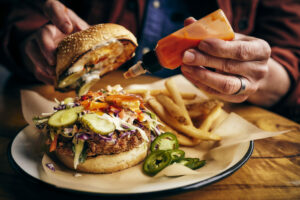
Celebrity chef Crista Luedtke’s new restaurant anchors a food-lover's perfect weekend in the Russian River town of Guerneville.
The post Best Places to Eat, Drink and Stay in Guerneville appeared first on Sonoma Magazine.
]]>












These days, for those in the know, Guerneville is one of the area’s best summertime retreats, brimming with chef-driven restaurants and reimagined old-school resorts that celebrate the redwoods and the Russian River.
It’s a spot where LGBTQ+ culture shines, earning the town the nickname the “Gay Riviera.” Though Guerneville hosts their Pride parade in October, it’s a destination for food lovers at any time of year—especially during those long summer evenings of Pride Month in June.
Start your weekend with a stroll downtown, chockablock with dive-y yet convivial bars, a few so-tacky-they’re-fun souvenir shops, and tasting rooms. Pick up hearty sandwiches at PikNik Town Market (16228 Main St., 707-604-7295, pikniktownmarket.com). New owner Mags van der Veen still serves the Oprah-approved Big Bottom biscuits, stuffed with delights like fresh blueberries and Bavarian cream, or smothered in mushroom gravy.
Armstrong Redwoods State Natural Reserve (17000 Armstrong Woods Rd., 707-869-2015, parks.ca.gov) is an 805-acre forest of redwoods towering up to 350 feet, just a mile or so from downtown. Breathe deep and savor the velvety quiet and solitude; the massive trees are often shrouded in mystical fog.
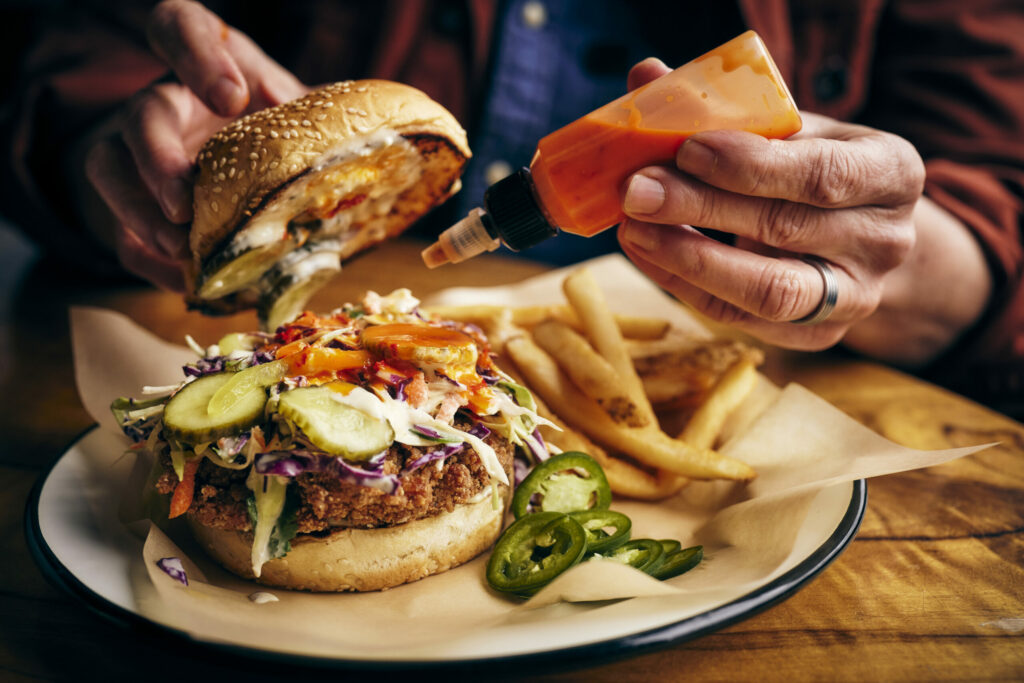
After a hike, head to celebrity chef Crista Luedtke’s brand-new Road Trip restaurant (16248 Main St., 707-869-0780), where the opening menu is inspired by Luedtke’s travels, including Texas BBQ flatbread with pulled pork, banh mi panzanella salad, Mexican street corn salad, and the Mac Daddy burger. Then it’s time to waddle off to sleep.
In the morning, start off with a short walk through town, poking into galleries and shops including local favorite Russian River Books & Letters (14045 Armstrong Woods Rd., Guerneville, 707-604-7197, booksletters.com) — coffee is right next door.
After, wander down to Johnson’s Beach (16215 First St., johnsonsbeach.com), where you can dip your toes in the Russian River, rent inner tubes and kayaks, or just relax under an umbrella.
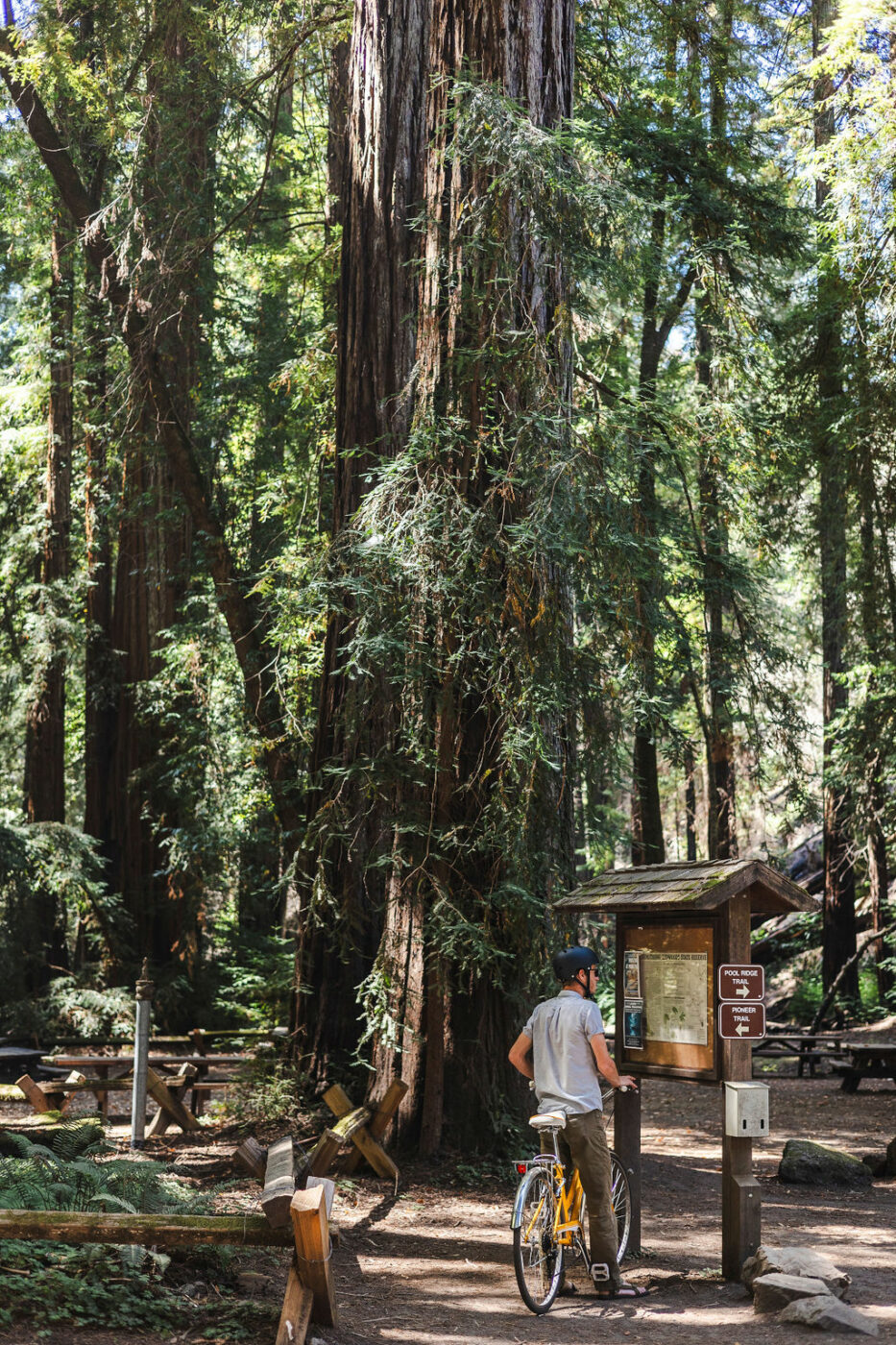
Then drive over the Russian River bridge for a tasting at Porter-Bass Winery (11750 Mays Canyon Road, 707-869-1475, porter-bass.com). Cooled by ocean breezes, their biodynamic vineyards produce top-notch Pinot Noir, Chardonnay and Zinfandel. Tastings are held at a wood plank set up under a shady walnut tree, in the company of veggie plots, orchards, dogs and cows.
Nearby is the historic (but recently renovated) Dawn Ranch (16467 Hwy. 116, 707-869-0656, dawnranch.com), where chef Fernando Trocca can prepare a storybook picnic to savor on the resort grounds, stocked with goodies like local cheeses, salumi, sea salt crusted hearth bread, fruit, chocolate, and optional wine (yes, get the wine).
In town, skip over to Nimble & Finn’s inside the Guerneville Bank Club (16290 Main St., 707-666-9411, nimbleandfinns.com) for a scoop of housemade artisanal ice cream made with Straus Family Creamery organic dairy, seasonal produce and housemade jams. Sisters and owners Jazmin Hooijer and Leandra Serena Beaver dream up magical concoctions like lavender honeycomb, Meyer lemon olive oil chocolate chunk and whiskey butterscotch.
Delight in dinner at boon eat + drink (16248 Main St., 707-869-0780). Another Crista Luedtke project, this always-bustling cafe wows with Sonoma County-spirited dishes, like some of the best mac and cheese you’ll ever have, dotted with mushrooms and truffle breadcrumbs, or spicy, chile-braised pork shoulder with slaw and pepitas. The flavors will carry you home—and rest assured, you’ll want to return.
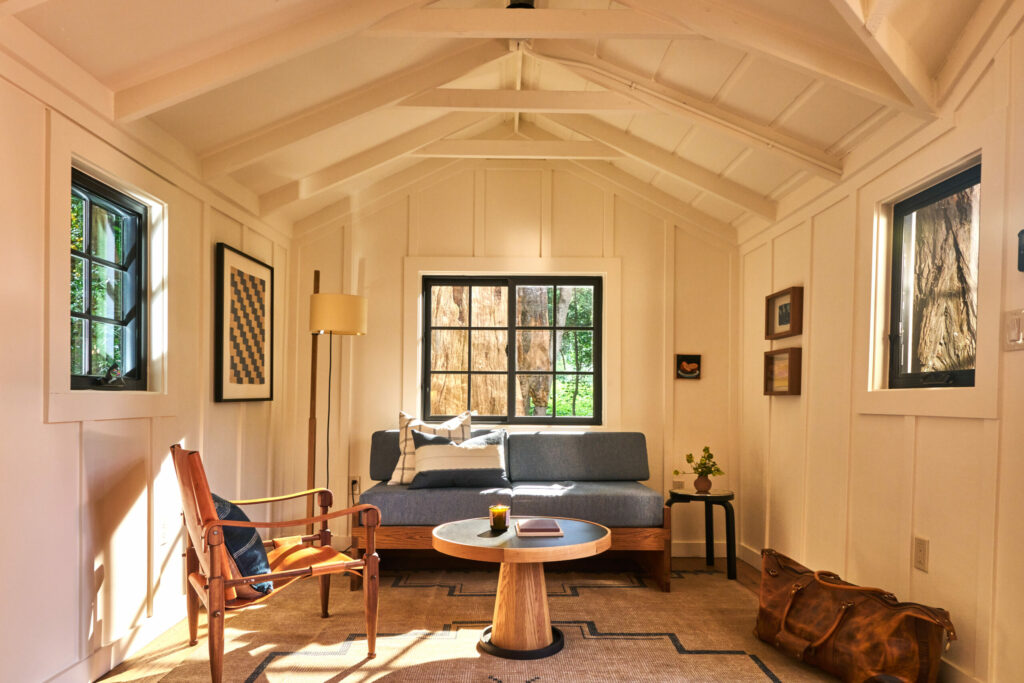
Where to Stay
boon hotel + spa A sister property to boon eat + drink with 14 rooms in historic miners’ cabins tucked amid stately redwoods, and a “Mad Men”-style glitzy swimming pool. 707-869-2721, boonhotels.com
Dawn Ranch Beautifully redone cabins with high-end finishes, plus orchards and forests to explore, including a rare dawn redwood tree which gives the resort its name. 707-869-0656, dawnranch.com
Johnson’s Beach Historic cabins, tent cabins, and camping by the river. johnsonsbeach.com
The Stavrand Russian River Valley Named to Travel + Leisure’s 2022 It List, the stately resort has been reimagined as a luxury destination with outdoor hot tubs under the stars. 707-869-9093, thestavrand.com
The post Best Places to Eat, Drink and Stay in Guerneville appeared first on Sonoma Magazine.
]]>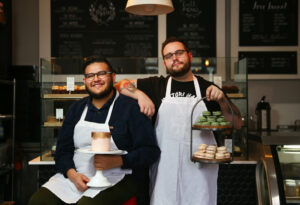
The community-minded couple behind Noble Folk Ice Cream & Pie Bar share some of their favorite, kid-friendly Sonoma County spots.
The post Couple Behind Beloved Bakery Share Favorite Sonoma Spots appeared first on Sonoma Magazine.
]]>












Sonoma County natives Ozzy Jimenez and Christian Sullberg met in 2010 and launched their beloved Noble Folk Ice Cream & Pie Bar in 2013 on the Healdsburg Plaza (a second location opened in Santa Rosa a few years later).
The couple are deeply involved in their community and celebrate diversity in every way, from proudly flying the rainbow and trans pride flags outside their stores to giving back to local organizations. Sullberg served on the board of Positive Images, a LGBTQ+ nonprofit, and Jimenez is the former mayor of Healdsburg and the first Latinx immigrant to serve on the city council.
Their lives took on a new resonance last year when the couple became parents to son Henry, who will be a year old in September.
“The activities that we enjoyed before now come in through a different filter,” says Jimenez. “When we go to a restaurant now, it’s like, ‘Is it kid-friendly?’ ‘Is there room for a stroller?’”
The couple shop for gender-neutral baby clothes at Bon Ton Baby on the Healdsburg Plaza and love to try new baby-friendly restaurants and hikes around town.
Here are some of Jimenez and Sullberg’s favorite Sonoma County spots:
Jimenez and Sullberg visit Asiana Supermarket in Cotati for pickles, daikon radishes, marinated short ribs, bibimbap—and their favorite kimchi, locally made Ji’s Kimchi. “Sunday is the day you want to go to the market, because sometimes you’ll see older women in their traditional Korean attire, doing their shopping.”
Asiana Market, 707-664-0526. Ji’s Kimchi, ginajikimchi.com

When Jimenez served as mayor of Healdsburg, he helped establish the city’s flag-raising policy to celebrate Pride Month in June. “Christian grew up here in Healdsburg, and for the longest time, there really hadn’t been positive affirmations of our identities… Now, there’s a flag at the police station, at the community center, at city hall. And the city lights up Memorial Bridge in rainbow. It legit looks like you’re going to the Wizard of Oz, and it’s just magical,” says Jimenez.
Sullberg and Jimenez love the new Maria de Los Angeles mural at Santa Rosa’s Luther Burbank Center. “It’s just a beautiful representation of her life growing up in Sonoma County,” says Jimenez.
707-546-3600, lutherburbankcenter.org

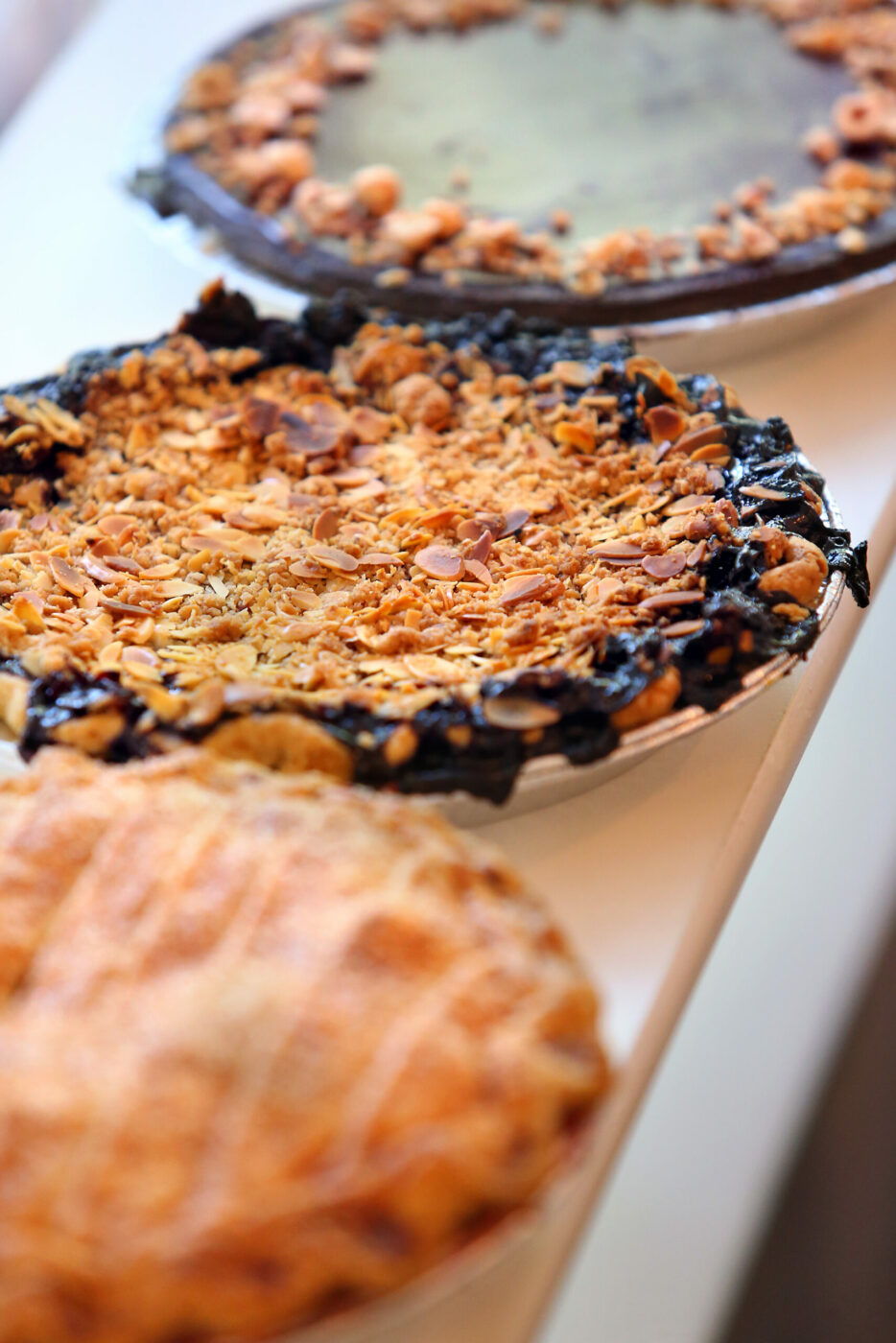
Of course, they know all the most delicious things to try at Noble Folk Ice Cream & Pie Bar. “For summer, Christian love-love-loves the peach-raspberry pie and the Dutch cookie ice cream,” says Jimenez. “And for me, it’s the French macarons—there aren’t a whole lot of places in the county that still make them fresh.”
In Healdsburg and Santa Rosa, thenoblefolk.com
They can’t wait to bring Henry on their favorite waterfall hike at Sugarloaf Ridge State Park, and, when he’s old enough, to the park’s Robert Ferguson Observatory to see the stars. “People drive from all over the Bay Area to participate in their programming in the summer,” says Jimenez.
707-833-6979, sugarloafpark.org, rfo.org
The post Couple Behind Beloved Bakery Share Favorite Sonoma Spots appeared first on Sonoma Magazine.
]]>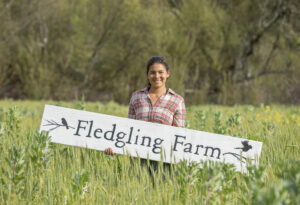
Grower Alice Tibbetts has launched a no-till produce operation on shared land in Sebastopol, and aims to make farming more sustainable for the farmer.
The post This 22-Year-Old Farmer Is Building a Sebastopol Farmstead From the Ground Up appeared first on Sonoma Magazine.
]]>












When Alice Tibbetts dreamed up the idea of Fledgling Farm, she was thinking about her own self-confidence as much as the farmstead.
“At first, it started with the idea of ‘full-fledged farm,’ because people don’t always believe that a small-scale, one-person operation can be a farm,” she says. “People want to call it a garden.”
But farm or garden, she took the leap.
“This idea of jumping from the nest is what Fledgling Farm means—the concept of coming to the edge of something kind of scary, and you know you have to do it and you know you can do it.”
It’s the perfect metaphor for a devoted no-till farmer, who at just 21 years old is building a farm and CSA from the ground up on 1.5 acres of shared land at Green Valley Farm + Mill outside Sebastopol.
As a pair of red-tailed hawks circle above and a knee-high cover crop blows in the breeze, Tibbetts is already envisioning what it will look like in June when her first CSA distribution arrives, with lettuce, radishes, turnips, scallions, kale, chard, peas and more.

As a young farmer of color, Tibbetts knows the struggle many go through trying to find land to farm. And she knows how lucky she is to have landed at Green Valley, where she can farm more than an acre and share the greenhouse and barn, while paying less than many people shell out for their monthly PG& E bill. It’s exactly what she had in mind when, as part of the National Young Farmers Coalition, she helped brainstorm ideas for the 2023 Farm Bill.
“We were trying to add legislation about land access,” she says. “I’m very aware how difficult it is for young, especially BIPOC, farmers to access land. So, the idea that I could land in this amazing community, with lots of resources and community recognition, and have it be so affordable, was an automatic yes for me.”
Growing up in a small town in western Massachusetts, Tibbetts helped out at a horse-plowed farm. At Bard College at Simon’s Rock, where she enrolled at age 16, she started
a campus farm club and founded a “farm house” where like-minded students lived together. After two years of college, she left to apprentice full-time, immersing herself in no-till farming, a practice that includes disturbing the soil as little as possible, keeping living roots in the ground and sequestering carbon. It’s how people grew food centuries ago.
“The whole philosophy behind no-till is that the soil and compost are sort of the plant’s stomach outside of its body,” she says. “It needs those other forms of life to process carbon and plant material and waste into nutrients. It can’t do that on its own.”
At a passion fruit vineyard in Hawaii, she discovered Korean natural farming, utilizing micro-organisms to enrich the soil. In Thailand, where her mother has roots, she learned about seed saving.
Along the way, she also learned about the sustainability of the farmer. In an age when farmer suicide rates are nearly four times the national average, she sees the evolution of farming in America coming around to the needs of the farmer.
“My parents’ generation, the back-to-the-land generation of new organic farmers, took the homesteading philosophies and found it was financially possible to do small-scale farming…Now, my generation is trying to make farming sustainable for the farmer. The goal is to hold everything that’s been done, learn from it, and choose to make it more sustainable for me in the long term.”
Fledgling Farm, 13024E Green Valley Road, Sebastopol. 413-270-5321, fledglingfarm.com
The post This 22-Year-Old Farmer Is Building a Sebastopol Farmstead From the Ground Up appeared first on Sonoma Magazine.
]]>